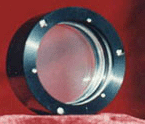|
||||
| Standard Specifications of KDP & DKDP | ||||
 |
Dimension tolerance: (W ± 0.1mm) x (H ± 0.1mm) x (L + 0.2mm / -0.1mm) | |||
 |
Transmitting wavefront distortion: less than l/4 @633nm | |||
 |
Clear aperture: > 90% central area | |||
 |
Flatness: l/8 @633nm | |||
 |
Surface Quality : 20/10 Scratch and Dig to MIL-O-13830A | |||
 |
Parallelism: better than 10 arc seconds | |||
 |
Perpendicularity: 5 arc minutes | |||
 |
Angle tolerance (degree): D(q) < ± 0.5, D(f) < ± 0.5 | |||
 |
Size: | KDP: 20x20x20mm ~ 200x200x200mm; DKDP: 15x15x15mm ~ 60x60x60mm | ||
|
Note 1. The surfaces of KDP and its isomorphic crystals are easy to be moistened. Customers should be very careful in the maintenance of crystal surfaces. The sealed housing is recommended for these crystals. 2. KDP isomorphic crystals are widely used as electro-optic modulators. |
||||
KDP & DKDP

